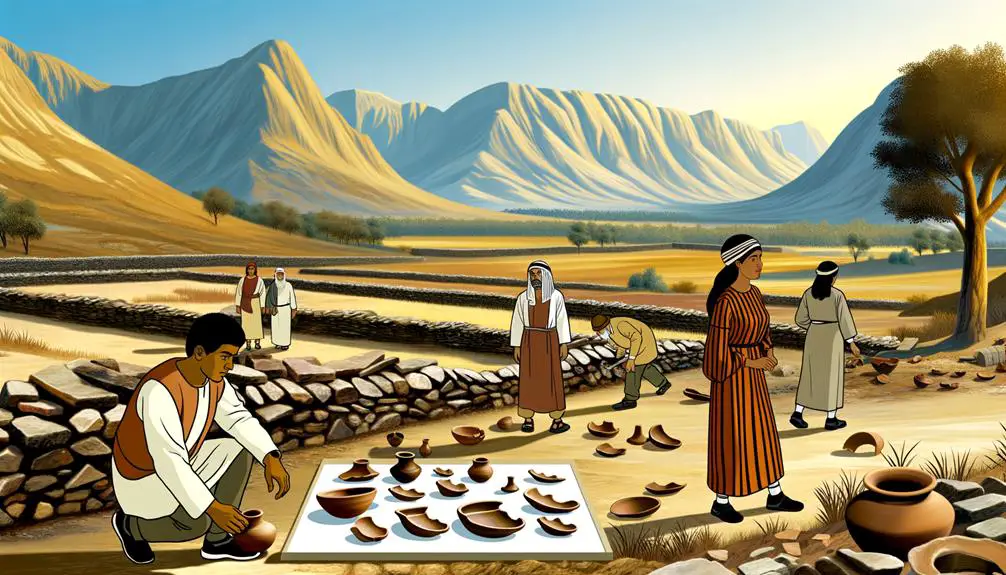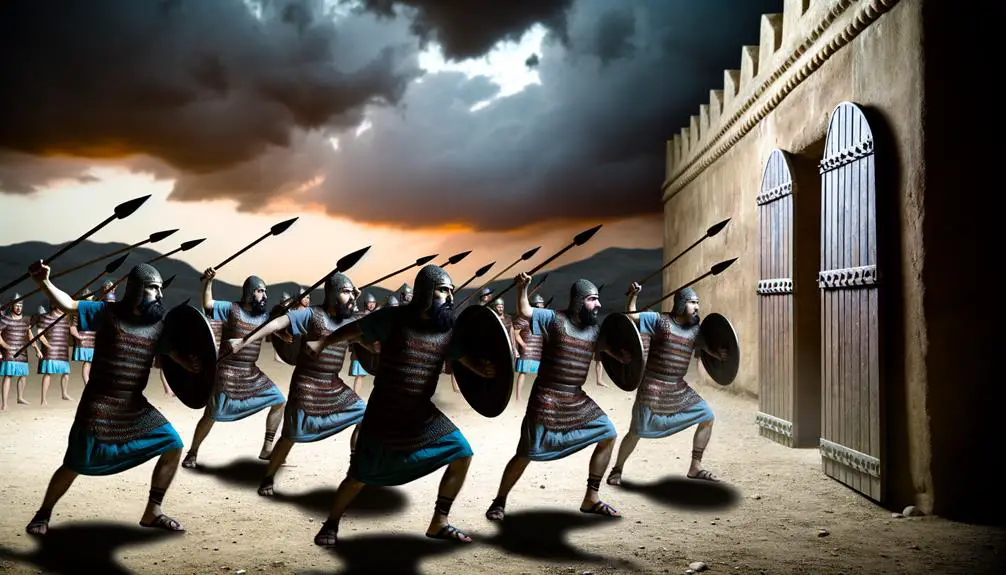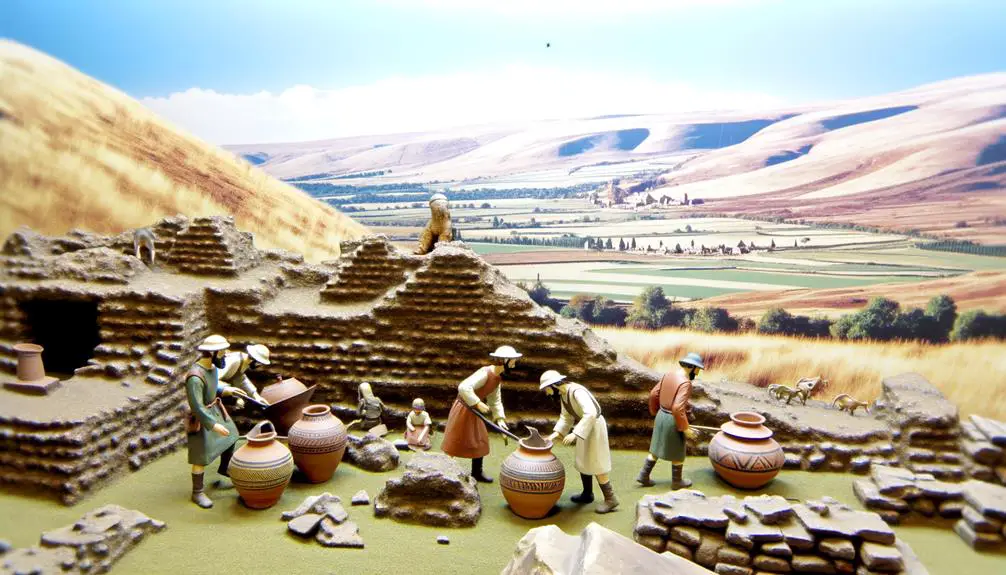Immerse yourself in the enigmatic tale of Heshbon, a biblical city where ancient battles and prophecies reveal layers of hidden history.

Heshbon in the Bible
In the ancient texts, Heshbon emerges as a city of conquest and prophecy; it's a place where history and mystery intertwine.
You'll find that its biblical references span narratives of battle victories and prophetic visions, hinting at a richness that goes beyond mere historical records.
As you explore Heshbon's past, you're stepping into a story that weaves through the fabric of time, offering insights into the spiritual and political landscapes of the era.
This journey into Heshbon's significance in the Bible will leave you pondering the layers of meaning that have accumulated over centuries, eager to uncover what lies beneath the surface.
Key Takeaways
- Heshbon's biblical narrative symbolizes prosperity, desolation, and divine will through its conquest stories.
- Artifacts from Heshbon provide physical evidence, merging faith and history for a deeper understanding of biblical contexts.
- The city's strategic importance and role in regional conquests highlight its significance in biblical history and narratives.
- Preservation of Heshbon's artifacts contributes to understanding its cultural practices and religious beliefs as mentioned in the Bible.
Historical Background of Heshbon

Heshbon, once a principal city of the ancient Amorites, has a rich historical tapestry woven through its strategic location and numerous conquests. You'll find its roots deeply embedded in the fertile grounds of history, where its geographical positioning played a pivotal role in its prominence and cultural significance. Situated east of the Jordan River, Heshbon's location served as a critical crossroads for trade, military, and cultural exchanges between the ancient civilizations of the Near East.
The city's strategic importance can't be overstated. It acted as a gateway between the eastern desert and the western agricultural lands, making it a coveted prize among empires and a melting pot of diverse cultures. This unique position fostered an environment where ideas, goods, and people intermingled, contributing to Heshbon's rich cultural tapestry. The city's influence extended beyond its immediate geographical boundaries, impacting the political and economic landscapes of the region.
Heshbon's cultural significance is further cemented by its role as a center for various civilizations. It was more than just a military stronghold or an economic hub; it was a place where cultures converged, where art, religion, and knowledge flourished. The city's legacy, therefore, isn't merely one of conquests and rulers but of human endeavor and cultural exchange.
Analyzing Heshbon's historical background, you'll uncover a narrative that transcends its archaeological remains. It's a story of human ambition, resilience, and the unyielding desire to connect and thrive. Heshbon's location and cultural significance make it a fascinating subject of study, offering insights into the complexities of ancient Near Eastern societies.
Heshbon's Biblical References

Exploring the historical backdrop of Heshbon sets the stage for a deeper understanding of its numerous mentions in biblical texts. You'll find that Heshbon's significance isn't just a matter of historical record but deeply intertwined with the cultural and spiritual narrative of the ancient Near East.
Heshbon appears in various capacities within the Bible, each highlighting different aspects of its cultural impact and significance. As you delve into these references, you'll notice that they serve to:
- Illuminate the strategic importance of Heshbon as a crossroads and its role in regional politics.
- Showcase Heshbon as a symbol of prosperity and desolation, reflecting the broader themes of divine judgment and redemption.
- Highlight the city's role in the narratives of conquest and settlement, providing insights into the historical and theological underpinnings of these events.
- Offer glimpses into the everyday life and spiritual practices of its inhabitants, contributing to our understanding of the cultural fabric of the time.
Analytically speaking, Heshbon's biblical references are a rich tapestry that weaves together tales of war, peace, prophecy, and poetry. This multifaceted portrayal not only reinforces Heshbon's significance in the ancient world but also underscores its cultural impact, resonating through generations. The city's presence in scripture acts as a conduit through which one can explore the complexities of human emotion, divine interaction, and the inexorable march of history.
In this way, Heshbon emerges from the biblical narrative not just as a geographical location, but as a living testament to the enduring power of faith, culture, and memory.
The Conquest of Heshbon

Delving into the biblical narrative reveals that the conquest of Heshbon marks a pivotal moment in the Israelites' journey towards establishing their presence in the Promised Land. The strategic significance of Heshbon, situated on the high plains east of the Jordan River, provided a considerable advantage in military and trade routes. This backdrop sets the stage for understanding the complexity of Sihon's strategy and the Israelites' military tactics that led to the downfall of Heshbon and its king, Sihon.
Sihon's strategy, as inferred from the biblical account, leaned heavily on the natural fortifications of Heshbon and the assumption that his forces could repel any incursion. However, this strategy underestimated the determination and resourcefulness of the Israelite forces. The Israelites, on the other hand, employed a combination of direct combat and psychological warfare, understanding the importance of Heshbon not just as a military target but as a symbolic victory paving their way to the Promised Land.
The conquest itself wasn't merely a testament to military prowess but also a reflection of the Israelites' strategic planning. They recognized that taking Heshbon would disrupt the Amorite kingdom's control over the region and open the door for further incursions into Canaan. The biblical text, while focusing on the divine aspect of their victories, also hints at the meticulous preparation and exploitation of weaknesses in Sihon's defenses.
Prophetic Visions and Heshbon

Prophetic visions play a crucial role in understanding the historical and spiritual significance of Heshbon within biblical narratives. When you delve into these ancient texts, you'll uncover that dream interpretations and visionary symbolism often provide insight into God's plans, judgments, and blessings for the people and places mentioned, including Heshbon.
Analyzing the prophetic visions related to Heshbon, it's evident that these revelations serve multiple functions:
- Guiding Leaders: They often contained directives for leaders, advising them on how to approach conflicts or governance, particularly concerning territories like Heshbon.
- Warning of Consequences: Visions frequently acted as warnings, foretelling the outcomes of disobedience or sin, which could befall communities associated with places such as Heshbon.
- Promising Restoration: Amid judgments, prophecies sometimes offered hope, promising restoration and blessing, hinting at a future where places like Heshbon would flourish once again.
- Symbolizing Divine Will: The visions symbolized the overarching divine will and plan, underscoring that every event, including those involving Heshbon, was part of a larger divine narrative.
These elements underscore the depth of dream interpretations and visionary symbolism in the biblical context. They're not mere stories but are loaded with meanings and messages, intricately woven into the fabric of biblical history and theology. In the case of Heshbon, these prophetic visions add layers to its story, illustrating not just its physical significance but also its place in the spiritual landscape of the biblical world.
Heshbon's Archaeological Insights

While examining the spiritual and visionary aspects of Heshbon offers profound insights, turning our focus to its archaeological discoveries can equally enrich our understanding of its historical context and significance.
The excavation challenges faced by archaeologists at Heshbon highlight the meticulous process of uncovering the past. These challenges aren't merely physical, such as the labor-intensive digging and careful removal of earth, but also intellectual, requiring the deciphering of the site's complex history through the artifacts and structures that emerge.
Artifact preservation is a vital component of archaeological work at Heshbon. Each item unearthed, from pottery shards to inscriptions, offers a unique window into the daily lives, trade, and cultural practices of its ancient inhabitants. The process of preserving these artifacts involves not only the immediate treatment to prevent further deterioration but also the long-term care to ensure they remain accessible for future generations. This aspect of archaeology demands a deep understanding of both the materials from which the artifacts are made and the environmental factors that can lead to their degradation.
The insights gained from the archaeology of Heshbon contribute significantly to our grasp of biblical narratives and the historical realities of the region. By overcoming excavation challenges and ensuring the meticulous preservation of artifacts, archaeologists provide a tangible connection to the world of the Bible, grounding spiritual and visionary understandings in the physical evidence of the past. This scholarly endeavor melds the realms of faith and history, offering a multidimensional perspective on Heshbon's place within biblical scholarship.
Frequently Asked Questions
How Has the Interpretation of Heshbon's Role in Biblical Narratives Evolved Among Modern Theologians and Biblical Scholars?
You've likely noticed that modern theologians and biblical scholars have shifted how they view Heshbon's significance. This evolution stems from archaeological findings and theological reinterpretations, deeply influencing their analysis.
Initially, discussions were more historical, focusing on physical evidence. However, as new data emerged, scholars began weaving these findings with theological perspectives, offering a richer, more nuanced understanding of its role.
This methodical, analytical approach has significantly broadened our comprehension of ancient narratives.
Are There Any Notable Artistic or Literary Works Inspired by the Biblical Accounts of Heshbon?
You'll find that artistic and literary works inspired by Heshbon often draw on archaeological findings and poetic interpretations. Creators delve into the rich historical tapestry, weaving narratives that bridge ancient times with modern insights.
These works, ranging from poetry to visual art, explore the depth of human experience connected to Heshbon. They not only honor its past but also spark scholarly discussions, enriching our understanding of its role across cultures and epochs.
How Do Contemporary Local Communities Around the Historical Site of Heshbon View and Interact With Its Biblical Heritage?
You'll find that contemporary local communities around Heshbon actively engage with its historical significance through archaeological tourism and community preservation efforts. They view the site not just as a tourist attraction but as a cultural and historical legacy that connects them to their past.
What Role Does Heshbon Play in Interfaith Discussions, Especially Between Jewish, Christian, and Islamic Scholars, Given Its Presence in Biblical Texts?
You're exploring how a historic site becomes a crossroads for interfaith dialogue.
Heshbon, with its archaeological significance, interestingly serves as a common ground for Jewish, Christian, and Islamic scholars.
They gather here, not just digging through layers of earth, but also through layers of shared and divergent faith narratives.
This process enriches interfaith dialogue, offering a unique opportunity for these communities to explore their connections and differences methodically and analytically.
Can Parallels Be Drawn Between the Biblical Stories of Heshbon and Similar Narratives From Neighboring Ancient Cultures or Civilizations, Highlighting Common Themes or Differences?
You're exploring whether stories similar to Heshbon's can be found in neighboring cultures, focusing on mythological parallels and cultural symbolism.
By analyzing these narratives, you'll pinpoint common themes or differences, enriching your understanding of ancient societies.
This methodical approach allows for a deep dive into the interconnectedness of myths, offering insights into how different civilizations perceived the world around them and how these perceptions influenced their cultural and religious practices.
Conclusion
In your exploration of Heshbon, you've journeyed from its ancient roots, through biblical narratives, witnessing its conquest, to prophetic visions that painted its fate.
Yet, juxtaposed against these historical and scriptural canvases are the tangible whispers unearthed by archaeology. This methodical examination reveals a tapestry where faith and facts intertwine, underscoring the complexity of interpreting a past both celebrated and mourned.
Heshbon stands as a testament to the dynamic interplay of history, prophecy, and discovery, inviting a deeper, analytical contemplation of its story.



Sign up